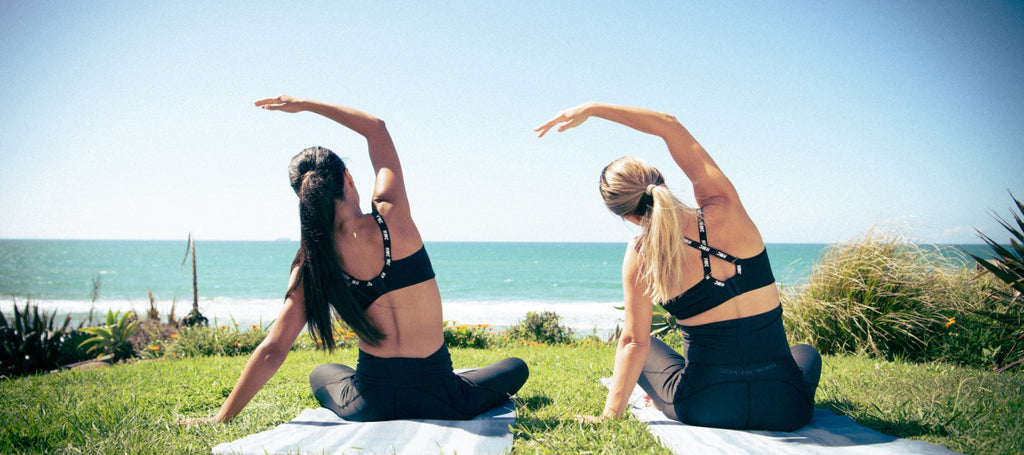HOW TO PLAN AND RECOVERY FROM A C-SECTION
Whether your baby is born vaginally or via caesarean, both require strength and courage. To help you plan for a caesarean birth or if you are looking for must-haves for your recovery, look no further. Our beautiful Hotmilk Community has kindly shared all their knowledge with us so we can pass it on to you.

Preparing and recovering from a caesarean section can be mentally and physically challenging. We often hear from mamas that they have or had their heart set on a vaginal birth, so if things don't go according to plan, it can be difficult to process. Much like breastmilk or formula fed, women often have a set idea of how things will play out and when it doesn't, it can be very distressing. We are here to say things often don't go to plan, and that's ok. Vaginal birth, C-section, formula fed, breastfed, mixed fed, doesn't make a difference to the mother you are.
With the help of our beautiful community, we have put together our top tips for planning and recovering from a c-section.

PLANNING FOR A C-SECTION
-
Understand the Caesarean procedure
Although it may be daunting, it is worth having your midwife and obstetrician talk you through the process. We suggest writing down your questions ahead of time. Here are a few examples of the questions you might ask - How many people will be in the surgery?
- Will I see my baby straight away?
- Can I still do skin-to-skin?
- If I can't do skin-to-skin, can my partner?
- Will my partner be in the room?
-
Create your birth plan
After meeting the obstetrician and midwife, create a birth plan. This can include things like delayed cord clamping and skin-to-skin. Establishing your needs with your partner, midwife, and doula will allow them to advocate clearly on your behalf. -
Can I have photos taken during my C-Section
There will be a lot going on when baby arrives. If you want a photo, make sure to ask someone ahead of time. You can check with your health provider for advice and recommendations. -
Understand the Caesarean recovery process
Every birth and recovery is different, but knowing the expected recovery times, limitations post birth, and how to best look after yourself and your baby is worth knowing. This will help you and your partner create the best recovery environment. We recommend this article for C-section Recovery Tips by Stephanie Watson and reviewed by Dr Stacy Henigsman. Highwaisted underwear such as My Necessity or Serenity, sit high on the waist and belly, causing no discomfort to tender areas during recovery. -
Hypnobirthing
This technique aims to reduce fear, pain, and anxiety during childbirth. It involves learning calm breathing techniques, deep relaxation, guided meditation, visualization, positive suggestions and affirmations. Hypnobirthing Australia has a fantastic online course covering vaginal and caesarean births. Alternatively, check to see if your midwife or doula has any suggestions. Hypnobirthing techniques are transferable to motherhood and everyday life. My Necessity is perfect to pack for the Hospital. -
Activity after a C-Section - physically limitations
Being a strong independent woman often makes this part of recovery challenging. - Protect your ab muscles: For the first 12 weeks after a C-section, avoid activities that make you breathe hard or strain your muscles.
- Take care of your incision: Your doctor will tell you how long to keep your wound covered.
- Take it easy: Never lift anything heavier than your baby while your incision is healing.
-
Postpartum Support
The best thing you can do to support yourself and your new baby is to ask for help. We suggest arranging support for up to three weeks post-birth. This could be childcare for an older child, help with the shopping or washing. Every little bit helps.
-
Organize pre-cooked meals
As mothers we often put ourselves last. In the flurry of newborn life the mothers needs are often secondary. Eating well is so important for you and your little one. There are a number of pre-made meals or meal kits on the market or start freezing meals ahead of time.
-
Postpartum bleeding
It is a common misconception that you don't bleed after birth if you deliver via caesarean. Make sure you stock up on pads and high waisted underwear. -
Colostrum
Often referred to as liquid gold, it is loaded with antibodies, white blood cells and other immunity boosting compounds. Most recommend starting colostrum harvesting after 36-37 weeks, but always check with your midwife or doula first.

C-SECTION RECOVERY TIPS
AS TOLD BY OUR HOTMILK COMMUNITY
- High-waisted comfy undies/pants. We have beautiful maternity brief options that won't irritate your incision. Try Serenity Bamboo, My Necessity Over the bump or My Necessity Bikini. All options can be worn during pregnancy and postpartum.
- SRC tights/compression tights/post-C-section belly band and a heat pack.
- Tubi grip is great for tissue support post birth.
- Chewing gum to help get the bowel working
- Antihistamines on-hand in case you get itchy
- A hair dryer use this (on low) to dry your incision post-shower for a few weeks
- Footstool for helping to go to the toilet
- To get out of bed, knot a bedsheet and tuck it under the bottom of your mattress
- Have straws on hand
- Set up your home so you don't have to bend.
- Invest in a long phone charger so you don't have to get up.
- A chair you can place in the shower.
- Support of friends & family.
For caesarean recovery, most healthcare professionals suggest no heavy lifting, driving or strenuous activity for at least six weeks, although each case differs. Once you have been checked by your doctor and cleared to exercise, we suggest starting very slowly. Here are a few of our favourite exercises to rebuild abdominal and pelvic floor strength.
OUR TOP FOUR EXERCISES FOR AFTER A C-SECTION
POST PREGNANCY EXERCISE
BELLY BREATHING OR DIAPHRAGMATIC BREATHING
A fantastic exercise to help train the core muscles to work as one, but also an incredible relaxation technique. Belly breathing has a ton of benefits and can be done anywhere.
- Lie on your back on a comfortable bed or couch.
- Place your hands on your belly and relax your body.
- Take a deep breath in through your nose, feeling your abdomen expand into your hands.
- Breathe out through your mouth. Pull your bellybutton in toward your spine as you exhale, contracting your abdominal muscles. Hold for 3 seconds.
- Repeat 5 to 10 times, 3 times a day.
SEATED KEGELS
Having a baby is extremely hard on your pelvic floor, and one of the best ways to rebuild strength is by doing seated kegels. Kegels are an excellent exercise to strengthen and activate the pelvic floor. In addition, after a C-section, you may have a urinary catheter, and these exercises will help after the catheter is removed.
- Sit on the edge of a chair with your feet on the floor.
- Contract the muscles of the pelvic floor. It should feel like you're trying to hold back the flow of urine.
- Imagine you're closing all the openings of the vagina, anus, and urethra. Imagine lifting them up away from the chair.
- Hold this contraction as long as possible. Start with 5 seconds and work up to a longer duration.
- Take a deep breath in and then breathe out fully, relaxing the contraction.
- Try Kegels in different positions like standing or lying on your side.
- Perform 8 to 12 times with a 2-minute rest between contractions. Repeat 2 times per day.
WALL SIT
The wall sit is tried and true; we have probably all done one at some point, and they are hard. It is a full-body isometric exercise and a great way to get all the muscle groups talking again. Incredibly helpful for post-birth as it works the abdominals and pelvic floor, among other muscle groups.
- Stand with your feet 1 to 2 feet away from the wall.
- Slowly lean back toward the wall, lowering yourself into a sitting position. Your hips and knees should be at 90 degrees to one another.
- Engage your core. Take a deep breath in and feel as if you're pulling your belly button into the wall while you exhale.
- For a bonus, contract your pelvic floor by doing a Kegel while holding this position.
- Hold for as long as possible. Rest 1 minute, then repeat 5 times.
BRIDGES
During pregnancy, your gluteal muscles can turn off due to postural changes. Learning to activate these muscles and contract with your deep abdominal and pelvic floor muscles helps stabilize your core and regain your hip and pelvic stability.
- Lie flat on your back with your knees bent and feet resting on the floor. You will want to bring your feet closer to your bottom before starting.
- Inhale to prepare.
- Exhale as you drive through your heels to raise your hips off the floor.
- In the top position, squeeze your buttocks and gently draw in your lower abdomen and pelvic floor.
- Inhale back down and repeat.

Most importantly, remember that you are recovering and don't overdo it. If you are looking for activewear to support your body while you move through the fourth trimester, we have an excellent range of tights and nursing bras.
Check out the range here!
- Focus Maternity leggings - Featuring a full height comfort waist panel that can be worn right over the fullest bump, a post preggy belly, or folded down for the ultimate support postpartum. Placement of seams for the pregnant body and c-section scars means zero irritation, with non-see-through fabric when bending, and no roll down.
- Reactivate Nursing Bra -Our Reactivate Sports Nursing Bra is designed for high-impact sports to reduce bounce and for all-day on-the-go support. Being active has never been so easy. This nursing bra is perfect for the fuller bust up to an H cup, padded front straps and a convertible racer-back to maximize support and comfort. Breathable with four-way stretch and a moisture-wicking lining.
- Zen Sports Bra - The lush feel of soft slinky microfiber, supported with foam cups, gives the ultimate comfort and all day wearability. Featuring convertible racerback no-slip straps and cotton A-frame nursing support, making breastfeeding on the go a breeze.
2021 the following statistics on caesarean births were recorded. 33% reported in AIHW Data for Australia, 32.1% reported in CDC Data for the USA, 34% in the UK were reported with NHS and 30.9 in NZ as reported to Te Whatu Ora. A caesarean section is an operation where a baby is born through an incision made through the mother's abdomen and the uterus (RANZCOG 2021). A caesarean section may be planned (elective), or unplanned (emergency) if complications develop and delivery needs to be hastened.
Caesarean section is one of the most common interventions in pregnancy and is safer now than in the past, however, a small risk of serious morbidity and mortality for both the mother and the baby remains (Betran et al. 2016; Villar et al. 2007; Keag et al. 2018)








